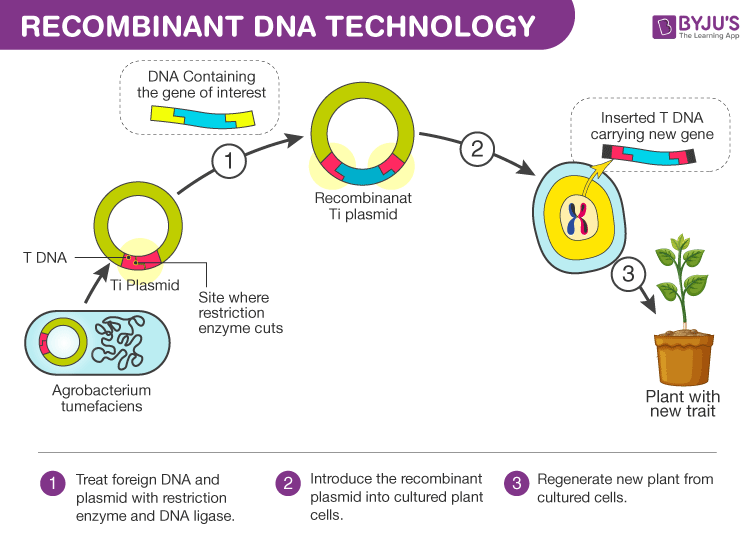A technique mainly used to change the phenotype of an organism (host) when a genetically altered vector is introduced and integrated into the genome of the organism. So, basically, this process involves the introduction of a foreign piece of DNA structure into the genome which contains our gene of interest. This gene which is introduced is the recombinant gene and the technique is called the recombinant DNA technology.
There are multiple steps, tools and other specific procedures followed in the recombinant DNA technology, which is used for producing artificial DNA to generate the desired product. Let’s understand each step more in detail.
What is Recombinant DNA Technology?
The technology used for producing artificial DNA through the combination of different genetic materials (DNA) from different sources is referred to as Recombinant DNA Technology. Recombinant DNA technology is popularly known as genetic engineering.
The recombinant DNA technology emerged with the discovery of restriction enzymes in the year 1968 by Swiss microbiologist Werner Arber,
Inserting the desired gene into the genome of the host is not as easy as it sounds. It involves the selection of the desired gene for administration into the host followed by a selection of the perfect vector with which the gene has to be integrated and recombinant DNA formed.
Thus the recombinant DNA has to be introduced into the host. And at last, it has to be maintained in the host and carried forward to the offspring.
Also Refer- Genes

Tools Of Recombinant DNA Technology
The enzymes which include the restriction enzymes help to cut, the polymerases- help to synthesize and the ligases- help to bind. The restriction enzymes used in recombinant DNA technology play a major role in determining the location at which the desired gene is inserted into the vector genome. They are two types, namely Endonucleases and Exonucleases.
The Endonucleases cut within the DNA strand whereas the Exonucleases remove the nucleotides from the ends of the strands. The restriction endonucleases are sequence-specific which are usually palindrome sequences and cut the DNA at specific points. They scrutinize the length of DNA and make the cut at the specific site called the restriction site. This gives rise to sticky ends in the sequence. The desired genes and the vectors are cut by the same restriction enzymes to obtain the complementary sticky notes, thus making the work of the ligases easy to bind the desired gene to the vector.
The vectors – help in carrying and integrating the desired gene. These form a very important part of the tools of recombinant DNA technology as they are the ultimate vehicles that carry forward the desired gene into the host organism. Plasmids and bacteriophages are the most common vectors in recombinant DNA technology that are used as they have a very high copy number. The vectors are made up of an origin of replication- This is a sequence of nucleotides from where the replication starts, a selectable marker – constitute genes which show resistance to certain antibiotics like ampicillin; and cloning sites – the sites recognized by the restriction enzymes where desired DNAs are inserted.
Host organism – into which the recombinant DNA is introduced. The host is the ultimate tool of recombinant DNA technology which takes in the vector engineered with the desired DNA with the help of the enzymes.
There are a number of ways in which these recombinant DNAs are inserted into the host, namely – microinjection, biolistics or gene gun, alternate cooling and heating, use of calcium ions, etc.
Also Read: Bioinformatics
Process of Recombinant DNA Technology
The complete process of recombinant DNA technology includes multiple steps, maintained in a specific sequence to generate the desired product.
Step-1. Isolation of Genetic Material.
The first and the initial step in Recombinant DNA technology is to isolate the desired DNA in its pure form i.e. free from other macromolecules.
Step-2.Cutting the gene at the recognition sites.
The restriction enzymes play a major role in determining the location at which the desired gene is inserted into the vector genome. These reactions are called ‘restriction enzyme digestions’.
Step-3. Amplifying the gene copies through Polymerase chain reaction (PCR).
It is a process to amplify a single copy of DNA into thousands to millions of copies once the proper gene of interest has been cut using restriction enzymes.
Step-4. Ligation of DNA Molecules.
In this step of Ligation, the joining of the two pieces – a cut fragment of DNA and the vector together with the help of the enzyme DNA ligase.
Step-5. Insertion of Recombinant DNA Into Host.
In this step, the recombinant DNA is introduced into a recipient host cell. This process is termed as Transformation. Once the recombinant DNA is inserted into the host cell, it gets multiplied and is expressed in the form of the manufactured protein under optimal conditions.
As mentioned in Tools of recombinant DNA technology, there are various ways in which this can be achieved. The effectively transformed cells/organisms carry forward the recombinant gene to the offspring.
Also Read: R-Factor
Application of Recombinant DNA Technology
- DNA technology is also used to detect the presence of HIV in a person.
- Gene Therapy – It is used as an attempt to correct the gene defects which give rise to heredity diseases.
- Clinical diagnosis – ELISA is an example where the application of recombinant
- Recombinant DNA technology is widely used in Agriculture to produce genetically-modified organisms such as Flavr Savr tomatoes, golden rice rich in proteins, and Bt-cotton to protect the plant against ball worms and a lot more.
- In the field of medicines, Recombinant DNA technology is used for the production of Insulin.
Also Refer: Genetically Modified Organisms (GMO)
DNA Cloning
A clone is a cluster of individual entities or cells that are descended from one progenitor. Clones are genetically identical as the cell simply replicates producing identical daughter cells every time. Scientists are able to generate multiple copies of a single fragment of DNA, a gene which can be used to create identical copies constituting a DNA clone. DNA cloning takes place through the insertion of DNA fragments into a tiny DNA molecule. This molecule is made to replicate within a living cell, for instance, a bacterium. The tiny replicating molecule is known as the carrier of the DNA vector.
Yeast cells, viruses, and Plasmids are the most commonly used vectors. Plasmids are circular DNA molecules that are introduced from bacteria. They are not part of the main cellular genome. It carries genes, which provide the host cell with beneficial properties such as mating ability, and drug resistance. They can be conveniently manipulated as they are small enough and they are capable of carrying extra DNA which is weaved into them.
Explore more: Genetic Disorders.
Applications Of Gene Cloning
Listed below are the applications of gene cloning:
- Gene Cloning plays an important role in the medicinal field. It is used in the production of hormones, vitamins and antibiotics.
- Gene cloning finds its applications in the agricultural field. Nitrogen fixation is carried out by cyanobacteria wherein desired genes can be used to enhance the productivity of crops and improvement of health. This practice reduces the use of fertilizers hence chemical-free produce is generated
- It can be applied to the science of identifying and detecting a clone containing a particular gene which can be manipulated by growing in a controlled environment
- It is used in gene therapy where a faulty gene is replaced by the insertion of a healthy gene. Medical ailments such as leukaemia and sickle cell anaemia can be treated with this principle.
Also Refer- Gene Therapy.
Stay tuned with BYJU’S to learn more about the Recombinant DNA Technology, its tools, procedure and other related topics at BYJU’S Biology.

Frequently Asked Questions
Explain the roles of the following:
(a) Restriction Enzymes
(b) Plasmids
b) Plasmid is an extra-chromosomal DNA molecule in bacteria that is capable of replicating, independent of chromosomal DNA. They serve as a vehicle to carry a foreign DNA sequence into a given host cell.
Explain PCR.
Discuss the applications of recombination from the point of view of genetic engineering.
- For the production of vaccines like the hepatitis B vaccine.
- Production of transgenic plants with improved qualities like insect and drought resistance and nutritional enrichment.
- Therapeutic protein production like insulin.
- Gene therapy in diseases like cancer, SCID etc.
- Production of transgenic animals with improved quality of milk and egg.


Thanks it is useful to send as a lecture notes during lock down period
Thank you so much. This module is really of great help in preparing an online class with my students.